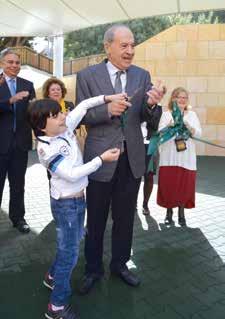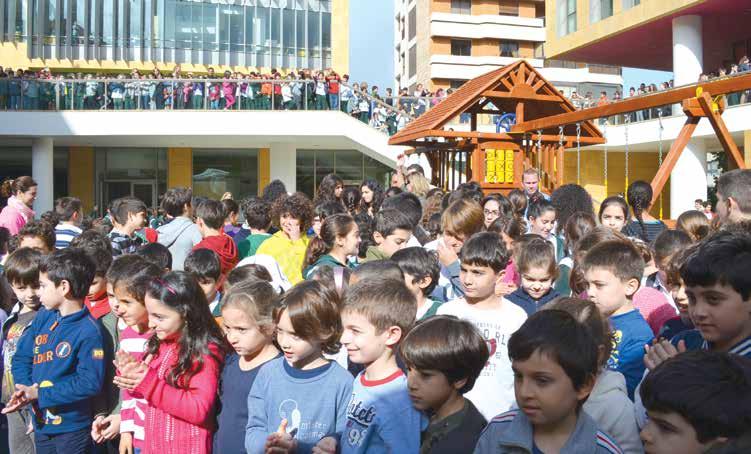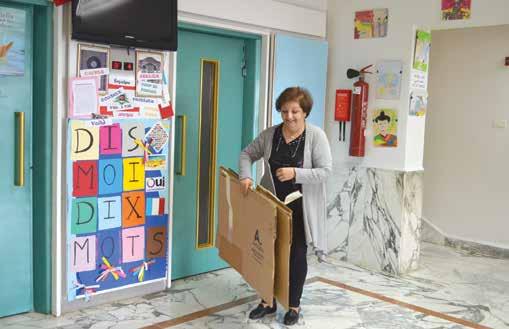
5 minute read
The Move
March 22, 2013. It’s the last day in the Elementary school – the building officially known as Reynolds Hall. On this last day, it is school as usual except for frequent ripping sounds resonating through the halls. Glimpses of teachers hovering over empty cardboard boxes filling them up one by one is an ever reminder that this is indeed an unusual day. In only a few more hours, the children will go home, teachers will tape up the last few boxes, and doors will be shut permanently. There is a distinct feeling of anticipation yet at the same time, a deep sense of melancholy. This building, after all, has been home for oh so many years. For those who have been here since 1984, when IC took it over from the British Embassy, it is a poignant moment. “What can I tell you?” says Najwa Haddad, the Office Manager and Secretary to the Elementary school director. “I have been here since the beginning. I saw generations grow here. This is so difficult for me.” Inside, French teachers Charles Tabet and Wael Issa, are in the teacher’s lounge – their last meeting in this building. “Twenty-five years I’ve been here,” exclaims Tabet. “How can I leave?” Next door, Mona Beyhum, is taking advantage of her students’ absence in the class to finish up packing. “I have been coming to this class every day for the past 26 years. My life is here…” she begins and stops. Tears escape. She struggles to hold them back. It is just too emotional. In a corner of the class there is a ‘suitcase of memories’ - the brainchild of Elementary school Director, Julia Kozak. Students had filled the suitcase with little ‘memorabilia’ to help them in their transition. Arabic teacher, Lina Oueidat, walks down the hallway – children in tow. “I’m excited,” she says, “but sad. I’ve become attached to this building. But change is good. It’s better for the students.” The students themselves seem excited. “But can we take the monkey bars with us?” asks one. “I don’t want to leave them here.” The child is quickly assured that there are other monkey bars in the new school. At 2:00pm the bell rings. The children start for home. At 3:30pm the teachers leave one by one. At 4:15 Kozak walks out the door and heads home. As she walks past the green gate, she pauses to look at the building and blinks tears away. The school had captured her heart 11 years ago when she arrived from Canada. They are precious years to her. “This is it,” she says to herself. “This is the last time I walk out of this door.” It’s been a good twenty nine years. The sparkling new Elementary school is on the hill just above. Its glass – some of it tinted – glitters under the sun. Inside, green, pink and blue walls await the children. Brand new desks and chairs await its new occupants. The old furniture was left behind. Teachers will only be bringing with them books and essential material.
Two weeks later, excited children arrive at the new Elementary school. The rain hardly dampens their enthusiasm. Wide eyed preschoolers look across their playground in surprise. Cardboard walls had blocked the view of the construction site for the past two years. Now, suddenly, the wall is down and there is another play-
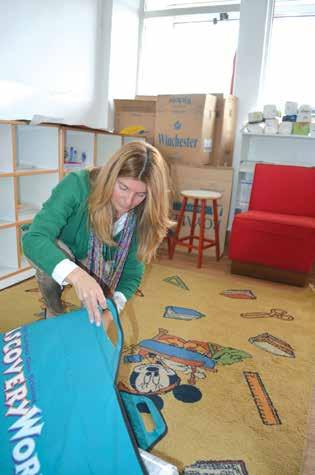
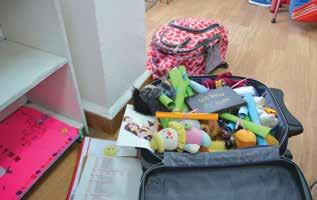
ground adjoined to theirs. Moreover, there are strange children in that playground. Who could they be? “They are ACS (American Community School) kids of course,” one preschooler is heard explaining. The rest of the preschoolers nod in agreement. The elementary school children are guided to their respective classes. As children do, they seem to have already taken a quick familiarity to it. There are still many corners to explore and halls to speed through. The adventure has just begun. Teachers seemed to have gotten over any melancholy as they proudly led their charges on a tour of the school. Beyhum, followed by her young students, waves cheerfully. The suitcase had been opened and the little ‘memories’ distributed. Hana Bekdache, Assistant to the Director, greets visitors with a beaming smile. “I feel so happy,” she says. “It’s like I have moved to a new home. It’s a fresh new start.” Kozak, of course, is on hand to welcome the children. She’s been back to the old Elementary School to collect some things and is relieved to report that the building without the ‘IC family’ is just an empty shell. “This is where we belong,” she says firmly. IC President, John Johnson, is the first to make it to the playground for the ribbon cutting ceremony to take place that morning. But it is still raining. Not that it fazes him. “My mother always told me that rain is good luck,” he says. He looks around in silence. Since his arrival in Lebanon seven years ago, building this school and scrutinizing the details has been a main preoccupation. He had to worry about every single detail. But the last chapter is this: plotting the details of the move. There were many worries for this day. Is it the right day for the move? Are the teachers ready? Is the right furniture in place? Will IC drop off times drastically congest Ras Beirut? All, it seems, went perfectly as planned. “I feel so good,” he says. “The kids are in school, the traffic worked, the children are excited.” He pauses. “It was a dream. And here we are.” At 9:00 am sharp, IC Directors and several board members joined the President to cut the inauguration ribbon. As if by cue, the rain suddenly lets up. Students file out to the playground. Some stand on the stairs, some on the walkway above and some stand with squished faces against their classroom windows overlooking the playground. The honor of cutting the ribbon went to Board Member Imad Taher ‘58 and his second grade grandson, Imad. As the Chair of the Buildings and Grounds Committee, he has been overseeing and approving every step of this project. “We wanted to have a beautiful school for beautiful children like yourselves,” he tells the gathered youngsters. “Study well and succeed. This is for you.” As the children return to their classes, Johnson and Taher walk slowly up the stairs. “It’s all been worth it, hasn’t it?” Johnson says. Taher nods silently as the two men make their way back to the main campus. Phase Number I – the building and moving to a new Elementary school is over. Just below, the old Elementary School stands forlorn. The usually impeccably clean entrance is littered by flying debris. The building was now a solid part of IC’s history.
